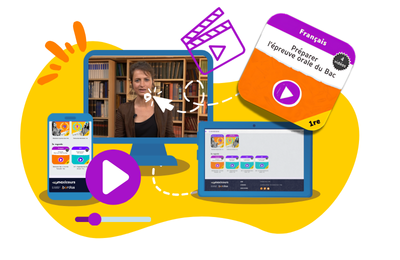William Turner and the Royal Academy
- Fiche de cours
- Quiz et exercices
- Vidéos et podcasts
- Découvrir un aspect de la thématique d'étude l'art qui fait débat
- Approfondir ses connaissances sur l'œuvre et la vie de William Turner
- William Turner est un peintre romantique spécialiste des paysages et des marines tourmentées.
- Il commence à étudier à l'Académie Royale à l'âge de 14 ans ! Il y enseignera d'ailleurs la perspective à partir de 1807.
- Aquarelliste à ses débuts, il est surtout connu pour ses peintures à l'huile. Sa plus célèbre est sans nul doute Rain, Steam and Speed.
- Sa capacité à restituer la lumière et les ombres sur ses toiles est impressionnante, en particulier celles du ciel, qui tient toujours une place importante dans ses tableaux.
- La couleur jaune est très employée dans ses différentes œuvres.
Joseph Mallord William Turner was –supposedly– born on 23 April, 1775. He is one of the greatest Romantic painters England has ever had. Known all over the world for his oil paintings he first became a watercolour painter and devoted himself to landscapes and violent marine paintings. A prolific artist, he died in 1851 after realizing 550 oil paintings, 2,000 watercolours and more than 30,000 other works and he is still considered today as the best landscape painter ever!
William Turner was a child prodigy and his father,
a Covent Garden barber and wig maker, was so
proud of his talents that he exposed his drawings in his
workshop whereas William was only 12. He started
painting in 1786 when he was sent to his
uncle’s who lived on the banks of the Thames
because his mother, who suffered from mental disturbance,
could not look after him. His taste for landscapes
probably found its origins there.
From 1789, he studied at
the Royal Academy and his first work,
A view of the Archbishop’s
Palace, Lambeth was displayed there when he
was 15.
He was then accepted into the academy by a famous painter, Sir Joshua Reynolds. He regularly exhibited watercolours and spent his time travelling and painting. Used to painting watercolours, he changed his technique in 1796 when he exhibited his first oil painting at the Academy, Fishermen at Sea.
In 1799, William Turner was elected an
Associate Member of the Royal Academy and
in 1802 he became a full Academician.
From 1807 he was
Professor of Perspective at
the Academy where he lectured until 1828
but he never became president of the prestigious
institution.
What characterizes Turner’s works today is how
he managed to capture light and shade in his paintings
–a great innovation– and some of them, like
Rain, Steam and Speed are considered as
highlights of his career.
As we can see here, skies mattered a lot to Turner. Indeed, most of his paintings featured the skies. Critic John Ruskin said he was ‘the’ artist who could most
And we can easily understand he meant the skies when he mentioned “the moods of Nature”.
William Turner was a controversial figure and
as the years went by he became more and more eccentric.
For instance, his sketches of nudes were disapproved of
by lots of people, even some of his friends were
embarrassed and they upset the Establishment. Others
criticized his excessive use of yellow in his works
and it made his detractors, jealous of his fame, say that
he had jaundice.
As far as his private life is concerned, we know that he
never married though two women shared his life: his
housekeeper Sarah Danby with whom he is said to have
had two daughters and Sophia Caroline Booth who
lived with him for about 18 years; he was then known
as “Mr Booth”.
He had few close friends but one of them was his father
whose death in 1789 plunged him into depression. He
then became pessimistic and morose and his health
deteriorated. He faced poverty from 1845 and
died of cholera six years later.
Precursor of the Impressionist movement, the Master of light leaves behind a considerable amount of paintings and influenced the classicist and romantic movements. He especially loved painting people, boats and landscapes. Fascinated with Nature and the sky in particular, he is even said to have muttered:
before passing away.
You can discover his works at the Tate Gallery
in London.

Des quiz et exercices pour mieux assimiler sa leçon
La plateforme de soutien scolaire en ligne myMaxicours propose des quiz et exercices en accompagnement de chaque fiche de cours. Les exercices permettent de vérifier si la leçon est bien comprise ou s’il reste encore des notions à revoir.

Des exercices variés pour ne pas s’ennuyer
Les exercices se déclinent sous toutes leurs formes sur myMaxicours ! Selon la matière et la classe étudiées, retrouvez des dictées, des mots à relier ou encore des phrases à compléter, mais aussi des textes à trous et bien d’autres formats !
Dans les classes de primaire, l’accent est mis sur des exercices illustrés très ludiques pour motiver les plus jeunes.

Des quiz pour une évaluation en direct
Les quiz et exercices permettent d’avoir un retour immédiat sur la bonne compréhension du cours. Une fois toutes les réponses communiquées, le résultat s’affiche à l’écran et permet à l’élève de se situer immédiatement.
myMaxicours offre des solutions efficaces de révision grâce aux fiches de cours et aux exercices associés. L’élève se rassure pour le prochain examen en testant ses connaissances au préalable.

Des vidéos et des podcasts pour apprendre différemment
Certains élèves ont une mémoire visuelle quand d’autres ont plutôt une mémoire auditive. myMaxicours s’adapte à tous les enfants et adolescents pour leur proposer un apprentissage serein et efficace.
Découvrez de nombreuses vidéos et podcasts en complément des fiches de cours et des exercices pour une année scolaire au top !

Des podcasts pour les révisions
La plateforme de soutien scolaire en ligne myMaxicours propose des podcasts de révision pour toutes les classes à examen : troisième, première et terminale.
Les ados peuvent écouter les différents cours afin de mieux les mémoriser en préparation de leurs examens. Des fiches de cours de différentes matières sont disponibles en podcasts ainsi qu’une préparation au grand oral avec de nombreux conseils pratiques.

Des vidéos de cours pour comprendre en image
Des vidéos de cours illustrent les notions principales à retenir et complètent les fiches de cours. De quoi réviser sa prochaine évaluation ou son prochain examen en toute confiance !








